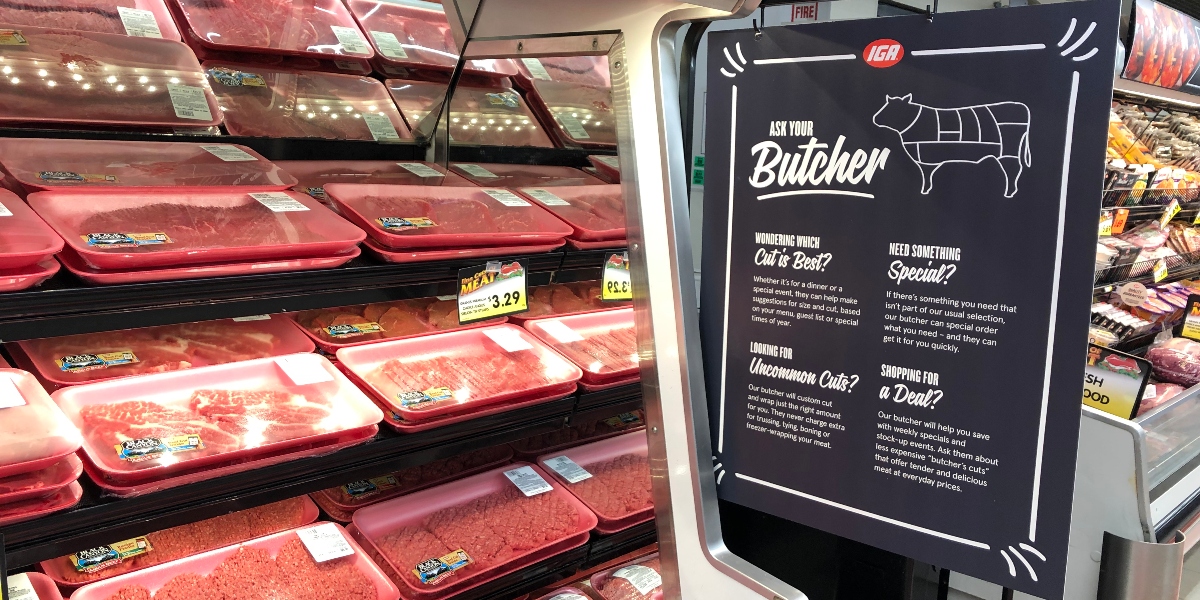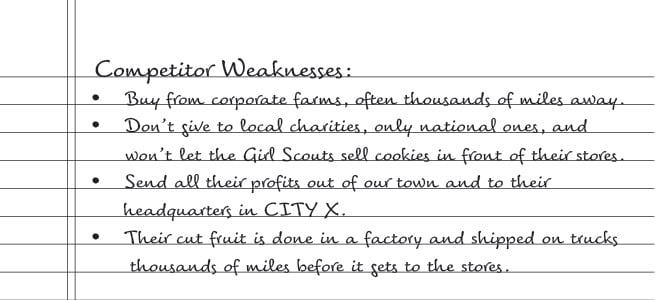Help Isom IGA recover from devasting floods

1 min read
De-positioning: The Subtle Art of Using Your Competitors’ Weaknesses Against Them
Written by John Ross
Jan 28, 2020
Welcome to Part II of IGA CEO John Ross' 3-part series on branding. Read Part I, Building a Brand, here.
Competing against bigger, national competitors can often feel overwhelming. They have so many resources, so much money to spend on marketing, it can often feel like an insurmountable challenge.
And let’s face it, there always seem to be more competitors, not fewer.
But IGA’s competitors are not perfect. In fact, big companies have just as many flaws as they have advantages. Identifying and exposing their flaws can often be a powerful marketing tactic to help shoppers choose your store over theirs.
I call this “de-positioning,” which means exposing the bad things competitors tend to do, and contrasting their shortcomings with our better, more heroic actions.
Here is an example de-positioning statement:
“Unlike national chains, we grind our beef fresh every day. You never have to worry about our meat coming from a factory thousands of miles away, sitting in trucks or on shelves, losing its taste and freshness!”
For IGA stores, with real meat cutters and top-quality meat, this sentence would be true. And for most national chains, it is true too that they increasingly use pre-packaged as a way to cut costs.
Let’s de-construct the sentence:
First, we start with the less-than-great thing our competitors do: pre-package and ship meat long distances.
Do our shoppers know they do this? Probably not. The meat in the Target or Walmart case looks just like ours. It’s even wrapped the same way. To the uninformed, their meat might appear just as good as ours.
And even if they knew we ground fresh today they wouldn’t necessarily know why it is better. We have to be overt about the benefits of what we do. “Nothing beats the quality and taste of fresh ground.”
So de-positioning not only exposes a less-than-great thing competitors do, it also explains to the shopper why what we do should matter.
Think of de-positioning as the words you hope your customers would say to someone who asks about your store. We essentially script their conversation ahead of time, if we do our job right.
In branding, de-positioning is a secret weapon. A powerful and effective weapon for sure. It lets you do three things with your messaging: move your shoppers toward your brand and at the same time drive them away from other chains, while educating your shopper about issues that should concern them.
This happens in the CPG industry all the time. You might see products that claim to be “all natural.” Who knows what that means? But if the claim is like this: “Unlike competitors, we never use artificial sweeteners, preservatives, or additives, so you only taste what nature intended,” now you’ve got a powerful educational message.
Of course, the branding experts that use de-positioning best are the political marketing folks. Right now, it’s hard to find a candidate who isn’t using this technique!
1. List your competitors' weaknesses
So how do you use it? Start by gathering your team and asking them to list all the things that your competitors do that your team’s expert managers (think deli, bakery, and produce, etc.) consider bad practices.

You get the idea.
Try to get your team to develop a full list of these kinds of statements. It might be slow to start, but once you really think about how they operate versus the way an independent chain behaves, you will find that it's easy to fill a white board full of statements just like this.
2. List your strengths by comparison
Then, take each statement and write next to it the good thing we do, by comparison:

It is important here to make sure what you say we do is true. Shoppers can see through phony marketing. That’s why phrases like, “wherever possible” help you out. We can’t say we buy exclusively from local farms, as that wouldn’t be true; we buy mangos from far away because they're grown far away. But if they were close, we’d buy from local farmers, right? So, saying, “wherever possible we buy from local farms” makes the sentence true, and still remains very powerful.
3. Identify why the shopper should care
Now, write why the shopper should care next to each sentence. For example:
Bad thing they do: Don’t contribute to local charities.
Good thing we do:
Support local organizations, give back to our community.
Why shopper should care: Keeps our town healthy.
Here’s another one:
Bad thing they do: All their profit goes to corporate HQ in CITY X.
Good thing we do: Local business, keeping our dollars local.
Why shopper should care: Creates local jobs, boosts city taxes and initiatives, etc.
Now, once you’ve got your lists, you have one last step. TELL YOUR SHOPPERS! De-positioning only works if you take the time to inform your consumers. Social media is great place for stories like this. Signs in store, posts on your website, and call-out boxes in your ads work great, too.
Your goal is getting shoppers aware of the difference, believing they are true, and repeating what you want them to know to their friends and family.
De-positioning works with all three of these goals because it helps inform the shopper. In many ways, it is more education than marketing. And they will love you for it because it helps them not only judge where to shop, but feel like a smarter shopper.
Big brands use this technique every day (remember the Apple versus PC ads?) because de-positioning is powerful.
I’d ask you to use a bit of time now in the first part of the New Year to write some de-positioning statements for your store. And then brainstorm all the ways you will tell those stories over the year.
The reality is that a local store does so many cool things big chains do not, it is a shame to have shoppers uninformed about the difference, and uninformed why it matters. De-positioning helps you and your team build confidence in how to beat the big guys. And it builds confidence with our shoppers why they should choose us over them.
Have you been doing any de-positioning in your market? We'd love to hear about it. Shoot IGA's Ashley Page an email at apage@igainc.com to tell us all about it!
Check out Part I of IGA CEO John Ross' 3-part series on branding, Building a Brand, and come back next week for Part III.
You May Also Like
These Stories on From the Desk of
Dec 18, 2025 9:32:36 AM |
3 min read
Dec 10, 2025 4:57:50 PM |
1 min read


No Comments Yet
Let us know what you think